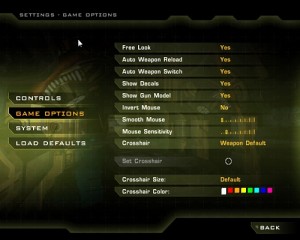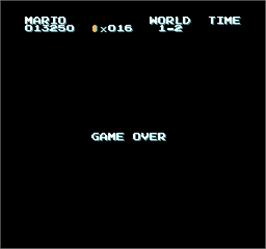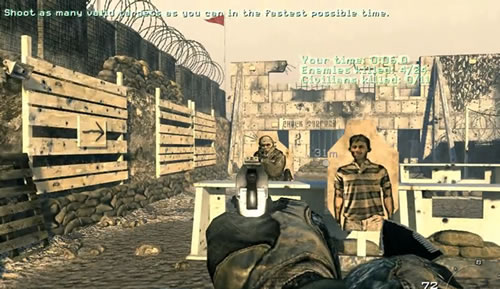Video games have come a long way over the years. The complexity of gameplay, objectives and story lines has continued to grow, leading game designers to devise clever and entertaining ways to explain what’s going on, what your goals are, and how the controls actually work.
The techniques used in video games can teach us lessons for all kinds of product experiences. Whether you’re explaining to users how your web app works or showing a user how to set up their smart phone for the first time, video games can help illustrate how to find the balance between instruction and entertainment.
Below are a few lessons that video games can share about creating great product experiences:
Don’t Expect People to Read the Instructions.
Many games include a tutorial at the very beginning to give users a hands-on lesson on how the game and controls works. The image above is from Call of Duty, showing the training course that serves as the first level. Simulating the actual gameplay in a structured environment gives users a chance to test things out.
Walking users through their first experience with your product will give them an opportunity to learn how to do something without any concerns about making a mistake or accidentally deleting something.
Take Advantage of Downtime
Most modern video games use load screens when first starting up or in between levels. It’s common to see tips or tricks included on these screens, so that users aren’t just staring at a dead screen. The image above (also from Call of Duty) shows how each load screen has an “Intel” area where game tips are shown.
With many products, there is going to be some inevitable downtime. It may be when a user is waiting for an email confirmation to show up in their inbox. Or as a travel site completes a search, or a device is being configured for the first time, or a piece of software is installing. Take advantage of that time to educate a user about a feature or tip that may not know about. By sprinkling this kind of information throughout the product experience, you will work towards building smarter and savvier users.
Build a Great Default Experience. Then Allow Users to Change It.
 When game designers create a game, a lot of thought is put into how the controls should be setup. When a user first picks up the controller, the interaction should be intuitive, responsive and enjoyable. So nailing the default setup is crucial.
When game designers create a game, a lot of thought is put into how the controls should be setup. When a user first picks up the controller, the interaction should be intuitive, responsive and enjoyable. So nailing the default setup is crucial.
But there are always users who want to have specific preferences. Maybe they are used to a layout from a different game and want to configure this game to work in a similar way. Not allowing for this type of customization can lead to annoyance and frustration.
Most users won’t change initial preferences, so focusing on building a good default experience is a must. But allowing power users to go in and edit the experience to their liking is an important part of building loyal fans.
Saving Progress Should Be Easy.
 I still remember playing the original Super Mario Brothers. Three lives, no way to save. You basically had to play it all the way through in one sitting. It was maddening (though oddly intoxicating for an 11 year old).
I still remember playing the original Super Mario Brothers. Three lives, no way to save. You basically had to play it all the way through in one sitting. It was maddening (though oddly intoxicating for an 11 year old).
Most games today employ Checkpoints. As you’re playing, you’ll hit a checkpoint and your game is automatically saved to that point. Having your work saved without requiring a user to manually take an action is a good idea for obvious reasons: we’ve all seen hours of work lost when something happens to our computer before we saved it.
The less responsibility that a product places on a user for having to do certain tasks or follow certain practices, the better. One example of this is a shopping cart on an e-commerce site. If a user has added something to their cart, it should be there the next time they come back, regardless of whether or not the last transaction was completed (or even if they have an account with that site).
(Note: as I write this post, I see a Draft copy being automatically saved every so often in the toolbar. Nice work WordPress!)
Video Games Are Nothing But an Extended Product Experience.
A video game is judged solely on the experience it provides a user with. By adopting some of the best practices used by video game designers, businesses can ensure customers find their products both entertaining and easy to use.

About Mark Webster
One of the Co-Founders of SideTour, former TechStar (NYC Summer 2011), ex-NBA'er, and past TechCrunch Disrupt Hackathon Winner.
- Tweets that mention How to Negotiate Like a Jamaican Taxi Driver | Websterism - Big Ideas. Small Budgets. -- Topsy.com: [...] This post was mentioned on Twitter by Mark C. Webster, Mark C. Webster. Mark C. Webster said: [...]
- Tweets that mention The Night Before Christmas REMIX (An ode to the bloggers who helped me change my life in 2009) | Websterism - Big Ideas. Small Budgets. -- Topsy.com: [...] This post was mentioned on Twitter by Jonathan Fields, Mark C. Webster. Mark C. Webster said: [...]
- Tweets that mention The Greatest Benefit of Working for Yourself | Websterism - Big Ideas. Small Budgets. -- Topsy.com: [...] This post was mentioned on Twitter by JenniferKeene, Mark C. Webster and Mark C. Webster, Smal [...]
- Tweets that mention The Power of Being First | Websterism - Big Ideas. Small Budgets. -- Topsy.com: [...] This post was mentioned on Twitter by Jason Markow, Mark C. Webster. Mark C. Webster said: The [...]
- Tweets that mention Dan Smith Will Teach You Marketing: An interview with a local New York legend | Websterism - Big Ideas. Small Budgets. -- Topsy.com: [...] This post was mentioned on Twitter by jascog. jascog said: For Manhattanites http://bit.ly/sM6 [...]
- Defining what personal failure looks like
- Want to clone my startup? Let me save you $5,757.
- What to Expect From a Disrupt Hackathon
- Getting Off on the Wrong Foot
- Why Groupon Could Be the Next Walmart (and why that’s bad for local businesses)
- Jason Calacanis Just Made His Company Mahalo One Big Hackathon
- Why You Should Stop Learning (and Start Doing)
- Should You Offer Rewards for Referrals?
- The Difference Between Tools and Talent (or what we can expect from Google App Inventor)
- Freelancing Advice: A Unique Approach to Billing Clients
Topics
- advertising (3)
- book reviews (2)
- branding (8)
- career (5)
- case studies (1)
- design (8)
- entrepreneur (44)
- general (1)
- ideas (27)
- lifestyle design (1)
- marketing (23)
- networking (5)
- running a business (9)
- viral (3)



